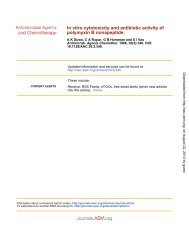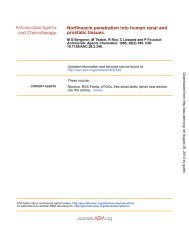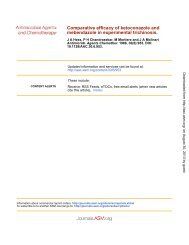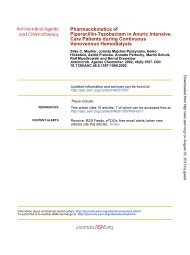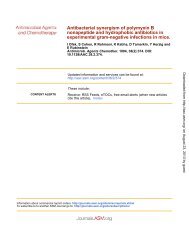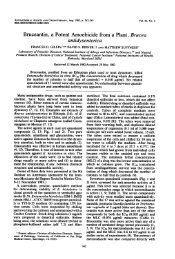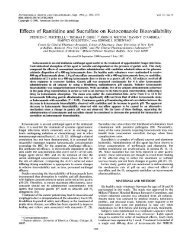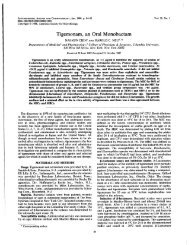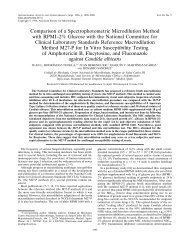In Vitro Susceptibility of Coxiella burnetii to Trovaffoxacin in ...
In Vitro Susceptibility of Coxiella burnetii to Trovaffoxacin in ...
In Vitro Susceptibility of Coxiella burnetii to Trovaffoxacin in ...
You also want an ePaper? Increase the reach of your titles
YUMPU automatically turns print PDFs into web optimized ePapers that Google loves.
2748 NOTES ANTIMICROB. AGENTS CHEMOTHER.<br />
Isolate<br />
TABLE 2. Antibiotic susceptibilities <strong>of</strong> C. <strong>burnetii</strong> isolates<br />
Pefloxac<strong>in</strong><br />
at<br />
PCS a 3.8<br />
Ofloxac<strong>in</strong><br />
at<br />
PCS 3<br />
MIC (g/ml) <strong>of</strong>:<br />
Cipr<strong>of</strong>loxac<strong>in</strong><br />
at<br />
PCS 1.6<br />
Trovafloxac<strong>in</strong><br />
at<br />
PCS 2.2<br />
Clarithromyc<strong>in</strong><br />
at<br />
PCS 4<br />
Doxycycl<strong>in</strong>e<br />
at<br />
PCS 4.4<br />
N<strong>in</strong>e Mile 1 1 4 1 2 1<br />
Q212 4 2 8 2 4 2<br />
CP1 4 2 8 2 4 2<br />
CP2 1 1 4 1 2 1<br />
CP3 1 1 4 1 2 1<br />
CP4 2 1 4 1 2 2<br />
CP5 1 1 4 1 2 1<br />
CP6 1 1 4 1 2 1<br />
CP7 1 1 4 1 2 1<br />
CP8 1 1 4 1 2 1<br />
a PCS, peak concentration <strong>in</strong> serum (<strong>in</strong> micrograms per milliliter) for a s<strong>in</strong>gle<br />
dose <strong>of</strong> antibiotic.<br />
<strong>in</strong> tests with the Greek C. <strong>burnetii</strong> isolates as well as the tested<br />
reference stra<strong>in</strong>s. However, the same isolates were less susceptible<br />
<strong>to</strong> pefloxac<strong>in</strong> and clarithromyc<strong>in</strong>. Cipr<strong>of</strong>loxac<strong>in</strong> presented<br />
higher MICs for all tested stra<strong>in</strong>s.<br />
Two major problems are associated with the evaluation <strong>of</strong><br />
the antibiotic treatment <strong>of</strong> acute Q fever. First, it is usually a<br />
self-limited disease and mostly retrospectively diagnosed and<br />
<strong>in</strong> the chronic form, an evaluation <strong>of</strong> the success <strong>of</strong> therapy<br />
requires prolonged follow-up due <strong>to</strong> late relapses (3–5, 7–9).<br />
Second, the experimental evaluation <strong>of</strong> antibiotic therapy is<br />
problematic because C. <strong>burnetii</strong> is a strictly <strong>in</strong>tracellular pathogen<br />
and no successful animal model <strong>of</strong> chronic Q fever has<br />
been described so far (9). <strong>In</strong> cases <strong>of</strong> acute Q fever, a bacteriostatic<br />
effect is sufficient for enabl<strong>in</strong>g recovery, whereas <strong>in</strong><br />
cases <strong>of</strong> chronic Q fever, a bacteriostatic regimen is not curative<br />
(9).<br />
Tetracycl<strong>in</strong>e has been the ma<strong>in</strong>stay therapy for endocarditis<br />
(8, 9). However, recovery <strong>of</strong> viable C. <strong>burnetii</strong> from valve tissue<br />
after 4 years <strong>of</strong> therapy with doxycycl<strong>in</strong>e has been reported (8).<br />
The use <strong>of</strong> cotrimoxazole alone has failed <strong>to</strong> cure Q fever endocarditis<br />
(8, 9). Comb<strong>in</strong>ations <strong>of</strong> rifamp<strong>in</strong> with either doxycycl<strong>in</strong>e<br />
or cotrimoxazole have been used <strong>in</strong> treat<strong>in</strong>g Q fever<br />
endocarditis, with apparent success (9). Cl<strong>in</strong>ical data on the<br />
efficacies <strong>of</strong> macrolides are lack<strong>in</strong>g (4).<br />
More recently, a comb<strong>in</strong>ation <strong>of</strong> doxycycl<strong>in</strong>e with the lysosomotropic<br />
agent chloroqu<strong>in</strong>e displayed bactericidal activity <strong>in</strong><br />
vitro, but no def<strong>in</strong>itive cl<strong>in</strong>ical data were presented (4). Qu<strong>in</strong>olones<br />
exhibit <strong>in</strong> vitro activities aga<strong>in</strong>st rickettsiae and have<br />
produced encourag<strong>in</strong>g cl<strong>in</strong>ical results <strong>in</strong> Q fever patients (2,<br />
3). <strong>In</strong> our study, trovafloxac<strong>in</strong> showed bacteriostatic activities<br />
(MIC, 1 <strong>to</strong> 2 g/ml) <strong>in</strong> tests with C. <strong>burnetii</strong> stra<strong>in</strong>s that were<br />
better than those obta<strong>in</strong>ed with pefloxac<strong>in</strong>, clarithromyc<strong>in</strong>, and<br />
cipr<strong>of</strong>loxac<strong>in</strong>. The bacteriostatic activities <strong>of</strong> doxycycl<strong>in</strong>e and<br />
<strong>of</strong>loxac<strong>in</strong> were comparable <strong>to</strong> those <strong>of</strong> trovafloxac<strong>in</strong>.<br />
A comparison between its MIC and peak concentration <strong>in</strong><br />
serum cannot be used as evidence <strong>of</strong> trovafloxac<strong>in</strong>’s cl<strong>in</strong>ical<br />
efficacy, s<strong>in</strong>ce C. <strong>burnetii</strong> is an <strong>in</strong>tracellular pathogen. It is,<br />
however, <strong>in</strong>terest<strong>in</strong>g that the <strong>in</strong>tracellular concentrations <strong>of</strong><br />
cipr<strong>of</strong>loxac<strong>in</strong> for all the tested stra<strong>in</strong>s and those <strong>of</strong> pefloxac<strong>in</strong><br />
for two stra<strong>in</strong>s (Q212 and CP1) needed <strong>to</strong> be higher than their<br />
peak concentrations <strong>in</strong> serum <strong>in</strong> order <strong>to</strong> achieve bacteriostatic<br />
levels. This was not true for the other qu<strong>in</strong>olones tested. The<br />
same type <strong>of</strong> comparison produced favorable results for clarithromyc<strong>in</strong><br />
and doxycycl<strong>in</strong>e (Table 2). However, the determ<strong>in</strong>ation<br />
<strong>of</strong> the activities <strong>of</strong> trovafloxac<strong>in</strong> aga<strong>in</strong>st C. <strong>burnetii</strong><br />
stra<strong>in</strong>s showed that at a concentration <strong>of</strong> 4 g/ml, it was not<br />
bactericidal <strong>to</strong> either tested stra<strong>in</strong>.<br />
<strong>In</strong> conclusion, our results <strong>in</strong>dicate that trovafloxac<strong>in</strong> possesses<br />
promis<strong>in</strong>g <strong>in</strong> vitro activities aga<strong>in</strong>st bacteria <strong>of</strong> the<br />
C. <strong>burnetii</strong> species. Careful cl<strong>in</strong>ical studies are now required <strong>to</strong><br />
evaluate it for the treatment <strong>of</strong> Q fever <strong>in</strong>fection.<br />
REFERENCES<br />
1. Jabarit-Aldighieri, N., H. Torres, and D. Raoult. 1992. <strong>Susceptibility</strong> <strong>of</strong><br />
Rickettsia conori, R. rickettsii, and <strong>Coxiella</strong> <strong>burnetii</strong> <strong>to</strong> PD 127,391, PD 131,628,<br />
pefloxac<strong>in</strong>, <strong>of</strong>loxac<strong>in</strong>, and cipr<strong>of</strong>loxac<strong>in</strong>. Antimicrob. Agents Chemother. 36:<br />
2529–2532.<br />
2. Keren, G., A. Keysary, R. Goldwasser, and E. Rub<strong>in</strong>ste<strong>in</strong>. 1994. The <strong>in</strong>hibi<strong>to</strong>ry<br />
effect <strong>of</strong> fluoroqu<strong>in</strong>olones on <strong>Coxiella</strong> <strong>burnetii</strong> growth <strong>in</strong> <strong>in</strong>-vitro systems.<br />
J. Antimicrob. Chemother. 33:1253–1255.<br />
3. Levy, P. Y., M. Drancourt, J. Etienne, J. C. Auvergnat, J. Bey<strong>to</strong>ut, J. M.<br />
Sa<strong>in</strong>ty, F. Goldste<strong>in</strong>, and D. Raoult. 1991. Comparison <strong>of</strong> different antibiotic<br />
regimens for therapy <strong>of</strong> 32 cases <strong>of</strong> Q fever endocarditis. Antimicrob. Agents<br />
Chemother. 35:533–537.<br />
4. Maur<strong>in</strong>, M., and D. Raoult. 1996. Optimum treatment <strong>of</strong> <strong>in</strong>tracellular <strong>in</strong>fection.<br />
Drugs 52:45–49.<br />
5. Maur<strong>in</strong>, M., A. M. Benoliel, P. Bongrand, and D. Raoult. 1992. Phagolysosomal<br />
alkal<strong>in</strong>ization and the bactericidal effect <strong>of</strong> antibiotics: the <strong>Coxiella</strong><br />
<strong>burnetii</strong> paradigm. J. <strong>In</strong>fect. Dis. 166:1097–1102.<br />
6. Maur<strong>in</strong>, M., and D. Raoult. 1993. <strong>In</strong> vitro susceptibilities <strong>of</strong> spotted fever<br />
group rickettsiae and <strong>Coxiella</strong> <strong>burnetii</strong> <strong>to</strong> clarithromyc<strong>in</strong>. Antimicrob. Agents<br />
Chemother. 37:2633–2637.<br />
7. Raoult, D. 1991. Antibiotic treatment <strong>of</strong> rickettsiosis, recent advances and<br />
current concepts. Eur. J. Epidemiol. 7:276–281.<br />
8. Raoult, D. 1993. Treatment <strong>of</strong> Q fever. Antimicrob. Agents Chemother. 37:<br />
1733–1736.<br />
9. Raoult, D., and T. Marrie. 1995. Q fever. Cl<strong>in</strong>. <strong>In</strong>fect. Dis. 20:489–496.<br />
10. Raoult, D., H. Torres, and M. Drancourt. 1991. Shell-vial assay: evaluation<br />
<strong>of</strong> a new technique for determ<strong>in</strong><strong>in</strong>g antibiotic susceptibility, tested <strong>in</strong> 13<br />
isolates <strong>of</strong> <strong>Coxiella</strong> <strong>burnetii</strong>. Antimicrob. Agents Chemother. 35:2070–2077.<br />
11. Torres, H., and D. Raoult. 1993. <strong>In</strong> vitro activities <strong>of</strong> ceftriaxone and fusidic<br />
acid aga<strong>in</strong>st 13 isolates <strong>of</strong> <strong>Coxiella</strong> <strong>burnetii</strong>, determ<strong>in</strong>ed us<strong>in</strong>g the shell vial<br />
assay. Antimicrob. Agents Chemother. 37:491–494.<br />
12. Tselentis, Y., A. Gikas, D. Kodteridis, E. Kyriakakis, N. Lydataki, D. Bouros,<br />
and N. Tsaparas. 1995. Q fever <strong>in</strong> the Greek island <strong>of</strong> Crete: epidemiological,<br />
cl<strong>in</strong>ical, and therapeutic data from 98 cases. Cl<strong>in</strong>. <strong>In</strong>fect. Dis. 20:1311–<br />
1316.<br />
13. Yeaman, M. R., L. A. Mitscher, and O. G. Baca. 1987. <strong>In</strong> vitro susceptibility<br />
<strong>of</strong> <strong>Coxiella</strong> <strong>burnetii</strong> <strong>to</strong> antibiotics, <strong>in</strong>clud<strong>in</strong>g several qu<strong>in</strong>olones. Antimicrob.<br />
Agents Chemother. 31:1079–1084.<br />
Downloaded from http://aac.asm.org/ on August 31, 2013 by guest




